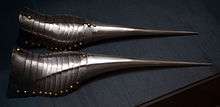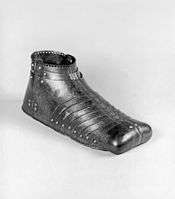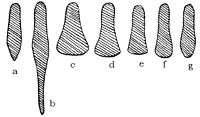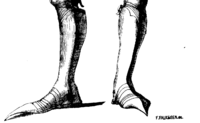Sabaton
A sabaton or solleret is part of a knight's armour that covers the foot.[1] Fourteenth and fifteenth century sabatons typically end in a tapered point well past the actual toes of the wearer's foot, following fashionable shoe shapes of the fourteenth century. Sabatons of the first half of sixteenth century end at the tip of the toe and may be wider than the actual foot. They were the first piece of armour to be put on, and were made of riveted iron plates called lames.
At least in theory, French princes and dukes were allowed to have toes of Gothic sabatons 2.5 feet (0.76 m) long, lords (barons and higher) 2 feet long and gentry only 1-foot (0.30 m) long.[2]
The sabaton was not commonly used by knights or men at arms fighting on foot. Instead, many would simply wear leather shoes or boots. Heavy or pointy metal footwear would severely hinder movement and mobility on the ground, particularly under wet or muddy conditions. Attacks against the feet are uncommon in dismounted combat, as a strike to an enemy's foot would typically put the attacker in a very awkward and vulnerable position. Conversely, a mounted knight's feet would be at perfect height for strikes from dismounted soldiers, and so sabatons or other foot armour would be vital when riding into battle.
-

Sabatons of Emperor Maximilian I, c. 1485
-

German sabaton for the right foot, c. 1550
-

Sabatons' shape evolution by Wendelin Boeheim: а) 1290—1390. b) 1300—1490. с) 1500—1530. d) 1530—1540. е) 1540—1550. f) 1550—1560. g) 1560—1590
-

Sabatons with tapered points (called à la poulaine)
